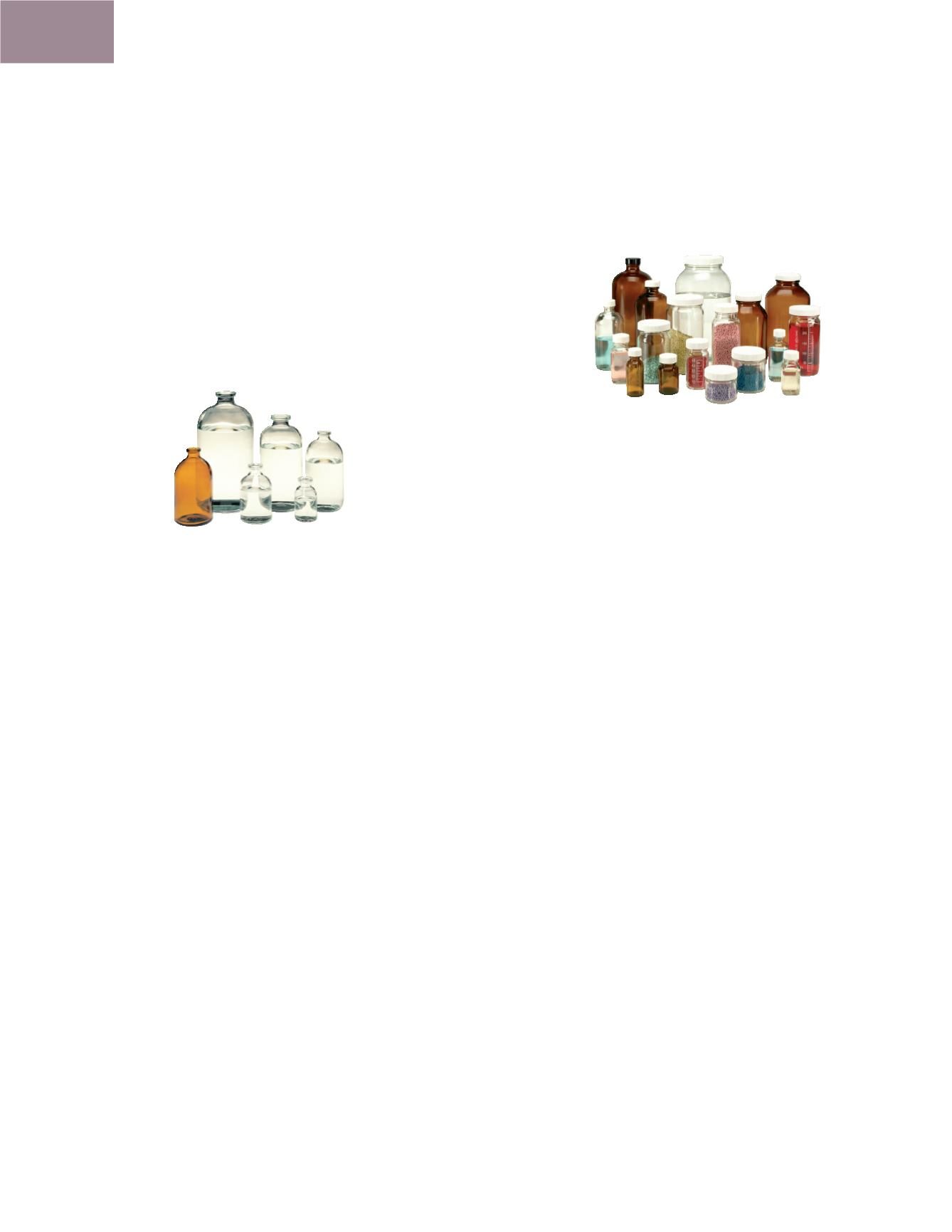

WHEATON
800.225.1437 (U.S. & Canada Only) | 856.825.1100 | 856.825.1368 (F) |
www.wheaton.comUSP Type II
USP Type II glass is soda-lime glass that has been treated with sulfur compounds to
de-alkalize the interior surface of the container. This treatment results in a container with
high chemical resistance because alkali is removed from the glass surface prior to use.
The amount of ions available to leach into the product is reduced, thus the container
durability is increased. Extraction salts will be present on the interior surface of new
sulfur treated containers, and the containers may require washing prior to use. Type II
glass is less chemically durable than Type I glass, but is more chemically durable than
Type III glass. It can be used for acidic and neutral parenteral preparations that remain
below pH 7 during their shelf life.
USP Type III
USP Type III is a soda-lime glass with moderate chemical resistance. It is typically
acceptable for packaging dry powders that will be dissolved into solutions or buffers that
are insensitive to alkali.
Type III glass may not be suitable for autoclaved products because the autoclaving
process will accelerate the glass corrosion reaction. Dry heat sterilization processes are
typically not a problem for Type III containers.
Factors other than USP Type
Handling Considerations
It is important to consider filling and processing steps when choosing a container. Both
mechanical and thermal stresses are important factors. For a given thermal expansion
range, a typical tubing vial with thin, uniform walls will withstand thermal shock better
than a molded glass container.
The physical design of the container will play a part in the amount of thermal and
mechanical shock resistance it exhibits. It is often necessary to make a compromise
between high resistance to mechanical shock and high resistance to thermal shock.
Light Sensitivity
Light sensitive products must be packaged in amber glass. Amber glass is formulated to
absorb light in the Ultra Violet region of the electromagnetic spectrum. Test methods and
specification limits for light protection can be found in the U. S. Pharmacopoeia.
Specific Ion Sensitivity
If a product is sensitive to the presence of particular ions, the composition of the glass
container should be considered. For example, products that contain sulfate salts may
experience the formation of precipitates if packaged in glass with barium or calcium in
the formulation. In this example, it would be desirable to avoid glass that contains barium
and calcium. A second example is pre-cleaned containers for environmental sampling.
Even though the containers are clean, the chemical durability characteristics of the glass
have not been altered. Thus, it would not be feasible to test the samples for low levels of
sodium, because the sample will extract sodium from the container’s surface.
Factors for Selecting a Glass Container
Chemical Durability
The U.S. Pharmacopeia classifies pharmaceutical glass containers according to their
chemical durability, which is their resistance to water attack. Different types of glass
react differently when exposed to solutions and vapors. Reactive substances will leach
constituents from the glass surface into the contained product. This reaction can occur
with ordinary aqueous, saline and alcohol based solutions. The primary ion removed
from the glass surface is sodium; however all elements are subject to leaching. It is not
uncommon to experience an increase in product pH as sodium is extracted from the
container. Corrosion of the glass occurs over time and is accelerated by moist heat-
treating processes like autoclaving.
Containers are classified by the USP as Type l, Type II and Type lll. Type I is the most
chemically durable glass and Type III is the least durable. Test methods and specification
limits are determined by the USP in Chapter <660> Containers. USP Type can be used as
a general guide for container selection but should not be the only criteria in the decision
making process. A set of criteria has been developed over the years to assist with the
selection of glass containers. These guidelines were established to narrow the selection
of possible containers. It is the product manufacturers responsibility to do testing to
ensure that the glass container is suitable for the application and contained product.
USP Type I
USP Type I classification is a borosilicate glass with superior chemical resistance. This
class of glass represents the least reactive glass containers available. Typically, this glass
can be used for most applications, including packaging for parenteral and non-parenteral
products. Type I glass may be used to package acidic, neutral and alkaline products.
Water for injection, unbuffered products, chemicals, sensitive lab samples and those
requiring sterilization are commonly packaged in Type I borosilicate glass. Type I glass
can be subject to chemical attack under certain conditions, thus container selection
must be made carefully for very low and very high pH applications. Most glass laboratory
apparatus are Type I borosilicate glass.
Even though Type I glass has the highest chemical durability, there still may be some
sensitivity with certain packaged products. For applications where standard Type I
glass does not provide sufficient protection against alkali extraction and pH shifting,
internal surface treatment can be used to further improve the chemical durability of the
container. This surface enhancement may become especially important for pH sensitive
products packaged in small containers because smaller containers have a higher surface
area to volume ratio. See the USP Type II description for an explanation of the internal
surface treatment process. It should be noted that the USP does not place any additional
durability requirements on surface treated Type I glass.
> 177
Technical Data, Glass
















